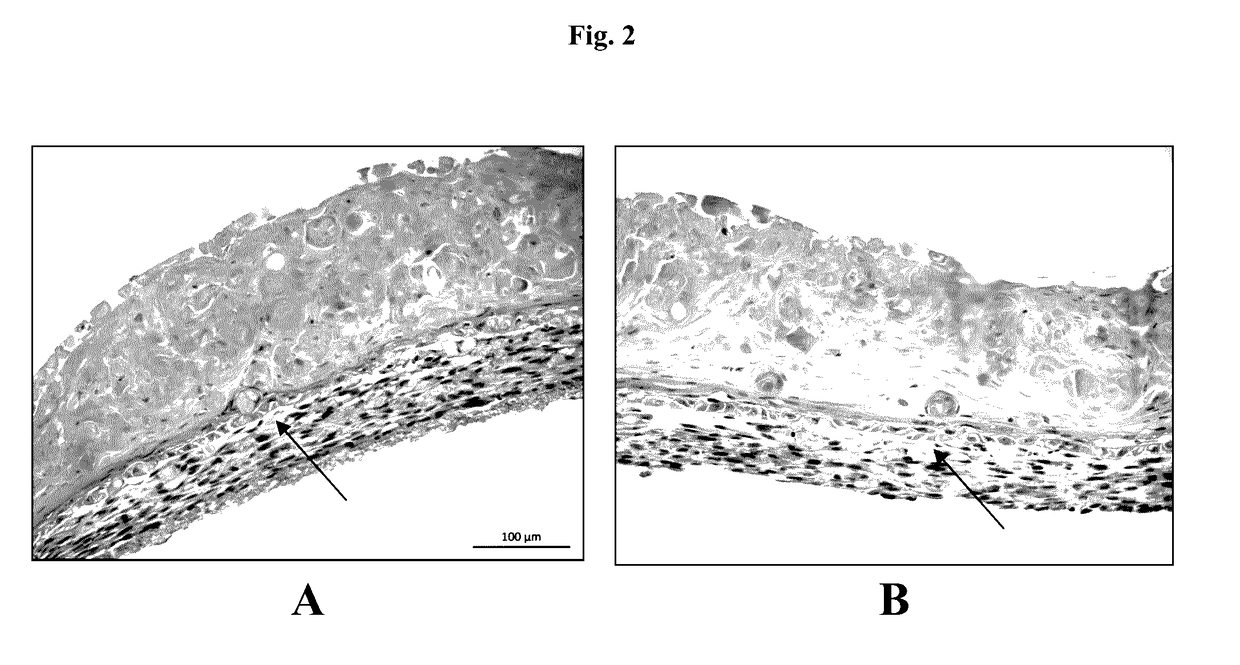Methods for tissue fabrication
- Summary
- Abstract
- Description
- Claims
- Application Information
AI Technical Summary
Benefits of technology
Problems solved by technology
Method used
Image
Examples
example 1
n Below 37° C. Improves Skin Tissue Formation
Procedures
[0088]Bio-ink was generated by a cellular mixture of 100% primary adult human dermal fibroblasts (HDFa) in 6% gelatin (Novogel® 2.0) in a concentration of 150 million cells per milliliter.
[0089]Three-dimensional bio-ink constructs were printed by continuous deposition using the Novogen Bioprinter® platform in a 4 mm×4 mm×0.5 mm base sheet with a 1 mm wall bordering the top to create a dermal structure resembling a cup. One tissue construct was printed per transwell in a 6 well plate. The transwell printing surface contained a polytetrafluoroethylene (PTFE) membrane coated with equimolar mixture of types I and III collagen (bovine) with pores 3 μm in size.
[0090]Epidermal cell paste containing a mixture of 95% primary adult human epidermal keratinocytes (HEKa) and 5% primary adult human epidermal melanocytes (HEMa) was then printed on top of the dermal bio-ink immediately or between 0.020 seconds and several hours or several days....
example 2
Exposure at 4° C. and Incubation Below 37° C. Improves Skin Tissue Formation
Procedures
[0099]Bio-ink was generated by a cellular mixture of 100% primary adult human dermal fibroblasts (HDFa) in 8% gelatin (Novogel®) in a concentration of 100 million cells per milliliter. The cell:gelatin ratio was altered to reduce the cellular density of the dermal sheet to better mimic dermal tissue in native skin.
[0100]Three-dimensional bio-ink constructs were printed by continuous deposition using the Novogen Bioprinter® platform in a 4 mm×4 mm×0.5 mm base sheet to create a dermal structure resembling a sheet. One tissue construct was printed per transwell—in a 6 well plate. The transwell printing surface contained a polytetrafluoroethylene (PTFE)-membrane coated with equimolar mixture of types I and III collagen (bovine) with pores 3 μm in-size.
[0101]Epidermal cell paste containing a mixture of 100% primary neonatal human epidermal keratinocytes (HEKn) was then printed on top of the dermal bio-i...
example 3
n Below 37° C. Improves Kidney Tissue Formation
[0111]The interstitial layer of the renal proximal tubule model is composed of renal fibroblasts and HUVECs in Novogel®. To reduce the thickness and cellularity of the interstitial layer, the cell ratio was changed to 50% fibroblasts / 50% HUVEC the concentration of the cells was 125 million cells / mL. Attempts to fabricate tissues using these cell ratios were hampered by a propensity of the tissues to “ball up,” preventing the sort of thin, spread out interstitial layer that is ideal. To assist in maintenance of construct shape following bioprinting, tissues were incubated at 30° C. for 3 days following printing to slow the rate of Novogel® dissipation.
[0112]The results show a tissue that better retains its overall dimensions (FIGS. 11C and D) after 30° C. incubation, when compared to 37° C. incubation (FIGS. 11A and B), and allows the cells to proliferate and secrete ECM to replace the Novogel® material as a binding agent (FIG. 11B). Fol...
PUM
 Login to View More
Login to View More Abstract
Description
Claims
Application Information
 Login to View More
Login to View More - R&D
- Intellectual Property
- Life Sciences
- Materials
- Tech Scout
- Unparalleled Data Quality
- Higher Quality Content
- 60% Fewer Hallucinations
Browse by: Latest US Patents, China's latest patents, Technical Efficacy Thesaurus, Application Domain, Technology Topic, Popular Technical Reports.
© 2025 PatSnap. All rights reserved.Legal|Privacy policy|Modern Slavery Act Transparency Statement|Sitemap|About US| Contact US: help@patsnap.com



